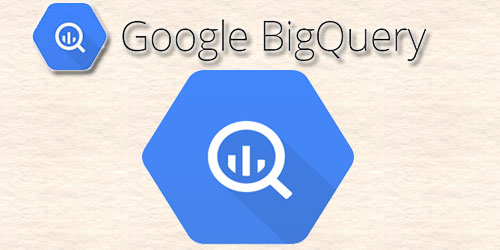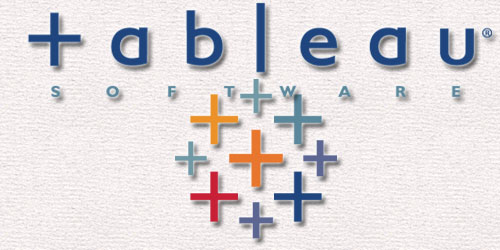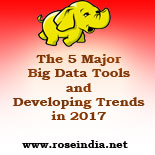Major tools and development trend of Big Data in 2017
Last year was a great time for Big Data and analytics, as they went on to make way into the organisations and in a better detailed manner. People in various fields learnt how to make greater use of the technology for extraction of information and applying them in various endeavours. Understanding the demands and managing the supply rate accordingly for efficient operations and desired results, gauzing the effectiveness of policies by government and the temperament of the public by government, treading new paths in scientific and technological inventions, etc. was aided to a great extent by this conceptual computing.
While Data Scientists came up as a new career opportunity, tutorials, colleges and IT organisations rushed to fill the gap in the skills and the requirement for the profiles that involve data warehousing, enterprise information management, governance, risk management, business intelligence, etc.

From an emerging concept in the testing phase to a new world of opportunities, Big Data and Analytics have covered a long distance for data mining and there is a lot of exploration left to be done. Although human skills are crucial, the performance of this technology depends largely on the tools or compatible software that are used for it. A large number of tools have inundated the markets and all of them boast of optimum efficiency in terms of outputs and cost.
Some of the software frameworks, which may be most used by the Big Data professionals in the present year based on the trends, are enumerated and detailed as follows:
Hadoop
Considered as the best tool it has retained its popularity and is expected to remain the most preferred even in 2017. So much so, that the name Hadoop has become almost synonymous with Big Data. It allows storage and dissemination of enormous data without the fear of hardware failure. From Machine Learning to sentiment evaluation to Artificial Intelligence, the insights of this tool shall touch new horizons.

However the interactive SQL is not so fast and efficient and same is the case with the security part. The SQl-On-Hadoop engines and OLAP-On-Hadoop technologies may aid the query accelerators (MemSQL, Exasol, Kudu, etc.) in removing the lacuna. Also the Hadoop deployments based on Cloud would take place of traditional distributions in the software. The Apache Sentry was also amalgamated with the tool for providing security layer to its applications such as Solr, Impala, and Hive by implementing role-based authorisations. This first commercially successful open-source ecosystem for Big Data celebrated its tenth anniversary last year and is adapting to positive changes with new integrations.
Spark
It is one of the Hybrid Processing Systems with the capability of fulfilling diverse processing requirements by having both the qualities of a batch processor and stream processor. It is developed on the same principle as MapReduce engine and is frequently used in its place for a speedy hook-up with Hadoop. Due to its in-memory processing and the Directed Acyclic Graphs (DAG) scheduling, it achieves a substantially high speed (about 100 times that of MapReduce).

Moreover, Spark makes a model called Resilient Distributed Datasets (RDD) to work with data and that helps in preventing faults. Apart from getting infused in the Hadoop Distributed Filing System (HDFS), the Spark can also act as a standalone cluster or with different data stores. The open-source, general computing engine can be used for real-time analytics as an alternative to Hadoop. Its flexibility and performance has led it to become very popular among the developers and it is among the probable names, which would get bigger this year.
Google BigQuery
An interactive Big Data analytical tool that works in synchrony with Google Cloud, is used by corporate giants, as well as, start-ups. It is a fully integrated tool which permits users to work with SQL-like queries, read and write data, without hassle of managing the database or infrastructure. As a Representational State Transfer (REST) compliant web service it lets the analysis of massive data sets done productively.

It is an economical, well managed and fast solution to otherwise expensive, complex and time consuming process of querying databases specially the append-only tables. The security aspect is also looked after with users controlling access to information. BigQuery is an Infrastructure as a Service, a form of cloud computing and can be used in concurrence of MapReduce. Google as progressive approach has undertaken various integrations, for e.g. with Qlik, SnapLogic, Talend, etc. for improving the performance of BigQuery. With all the technology rich features, it a highly prospective Big Data tool for the developers in future.
MongoDB
For the developers who wish to have accurate control over the end results, the MongoDB is quite an ideal tool. It is a cross-platform, open-source and document-based database program, categorised as NoSQL. Unlike typical relational database, which possess schema designs, showing tables and their inter-relation, MongoDB does not follow the theory of relation. The data, in its case, is stored in JSON-like documents, where the content, size, as well as, content, size and number of fields can be distinguished from one document to another.

In this schema less program, the structure of every object is clear. The easiness in scalability, dynamism in document querying, tuning, faster access to data are some of the advantageous features of MongoDB. The tool is often used in storing data in form of product catalogues, content management, mobile apps and other such applications enabling single view through the multiple frameworks. Fluentd, Edda and other log tools of the third-party are included in the framework.
Tableau
This tool is of much help in the field of business intelligence and is a pretty renowned program to be used in that sphere. Visualisation tool can be the actual other name of this software that specialises in providing different views of the same data in and diverse examining angles for two comparable data structures. Be it creation of scatter plots, maps, bar charts or any other graphical presentations, Tableau lends the ability to generate all without the programming need. The software framework, which is supported by an active users’ community, provides various useful tools to the users.

With the help of VizQL, a unique visual query language, the program resorts to translation of drag and drop operations into queries related to data and eventually to manifestation of results graphically. The In-Memory technology of Tableau comes to the rescue of the users who have to develop analytical reports on the foundation of an ever-expanding database. Apart from these, the swiftness, usability, ease of publishing and sharing the analytical reports and the interactive, visually pleasing dashboard are some of the positives of the tool.
Conclusion
In the coming year, there is a need for expansion of Big Data by turning the dark data or the unused data into fruitful terabytes and that too in a quick and precise way. The growth of Embedded Analytics as it provides greater insights into business and other aspects saving much time is also a trend that may take a bigger shape in 2017. The biggest drivers of investments in Big Data would be the triple factors, viz. High velocity, high variety and high volume of data. The multiplication of formats and integration of sources would play a big role in the approaching times ahead.
The switch to cloud-hosted services would certainly become increasingly important and so would be the dependency on Internet of Things (IoT), which is the intra-networking of hardware or devices for exchange of information. And lastly the exponential use of technological products and services certainly necessitate the formation of shield in form of Cyber security, against both internal and external elements. These upcoming trends generate certain criteria in respect of Big Data tools which the above listed programs fulfil to a large extent. It would be interesting to see how the trends turn true or what fluctuations or uncertainties upset the possibilities and in what way in 2017.
Big Data Tutorials
Check the following tutorials of Big Data and Data analytics: 0
